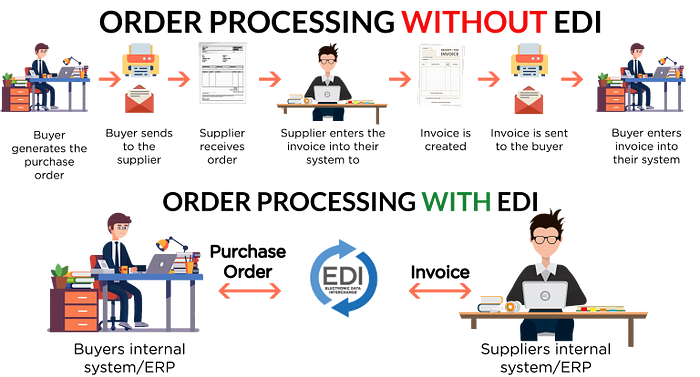Improving Business Efficiency with Electronic Data Interchange

Electronic Data Interchange is the exchange of business documents and data (invoices, orders, order responses, dispatching and receiving advice documents) across a variety of platforms in the form of electronic messages between the IT systems of business partners. The benefits of moving from a paper-based exchange of documents to EDI services include reduced errors, faster document processing, automated workflows, and improved business-partners relationships. Read this blog post to explore the technical architecture of the EDI network and its benefits for ERP.
We are an ERP software development company that provides EDI integration services for efficiently exchanging sensitive information.

Key Benefits of the Electronic Data Interchange:
Reduced Costs:
* EDI transactions reduce expenses related to paper, printing, copy, storage, filing, postage and document retrieval. In addition, EDI lowers the dealings prices by a minimum of 35%
* A major electronics manufacturer calculates the value of process an order manually at $38 compared to only $1.35 for an order processed mistreatment EDI
* EDI saves employees valuable time by reducing errors caused due to unreadable faxes, lost orders or incorrectly taken phone orders.
Enhanced Speed and Accuracy:
* EDI speeds up your business cycles by 61%. Exchange transactions in minutes rather than the times or weeks of wait time from the postal service
* EDI improves data quality, delivering a minimum of a 30–40% reduction in transactions with errors — eliminating errors from marked-up handwriting, lost faxes/mail and keying, and re-keying errors.
* Using EDI will scale back the order-to-cash cycle time by quite the 200th, rising business partner transactions and relationships.
Increased Efficiency:
* Automating paper-based tasks enables business executives to invest more time in higher-value tasks
* Faster processing of business documents results in less re-working of orders, fewer stock-outs and reduced off orders.
* Automating the exchange information between applications ensures that business-critical data is distributed on time
* Shortening the order process and delivery times means organizations will cut back their inventory levels.
Improved Business Strategies
* Enables period of time visibility into transaction status. This successively allows quicker decision-making and improved responsiveness to dynamic client and market demands and permits businesses to adopt a demand-driven business model instead of a supply-driven one.
* EDI reduces the lead times for product enhancements and new product delivery.
* Streamlines your ability to enter new territories and markets. EDI provides a standard business language that facilitates business partner onboarding anyplace within the world.
* Promotes company social responsibility and sustainability by substitution paper-based processes with electronic alternatives. this may each prevent cash and cut back your co2 emissions.
Technical Architecture of the Electronic Data Interchange:
In Electronic Data Interchange(EDI), three types of protocols are used for receiving and sending files from one place to another.
File Transfer Protocol (FTP)
FTP is a robust, reliable file transfer protocol developed and utilized by several businesses significantly for file exchange inside a corporation. However, FTP alone doesn’t give the protection required for document exchange with different corporations over the web. For this reason, businesses that use FTP use it in conjunction with VPN computer code, which provides the required protection layer.
Value-Added Network (VAN)
VAN is a non-public network provider whereby EDI (Electronic Data Interchange) documents are transmitted and exchanged. In alternative words, it’s a channel of communication to move data from point A to point B.
AS2:
AS2 is one of the most popular ways of transporting data, particularly EDI data, securely and reliably over the web. It basically involves 2 computers — a client and a server — connecting in a very point-to-point manner via the web. AS2 creates an “envelope” for the EDI data, permitting it to be sent securely — using digital certificates and encryption — over the web.
The following image will explain the working of the protocols over the network.
